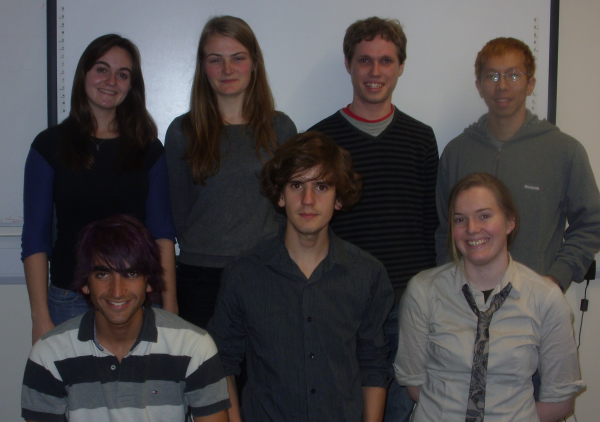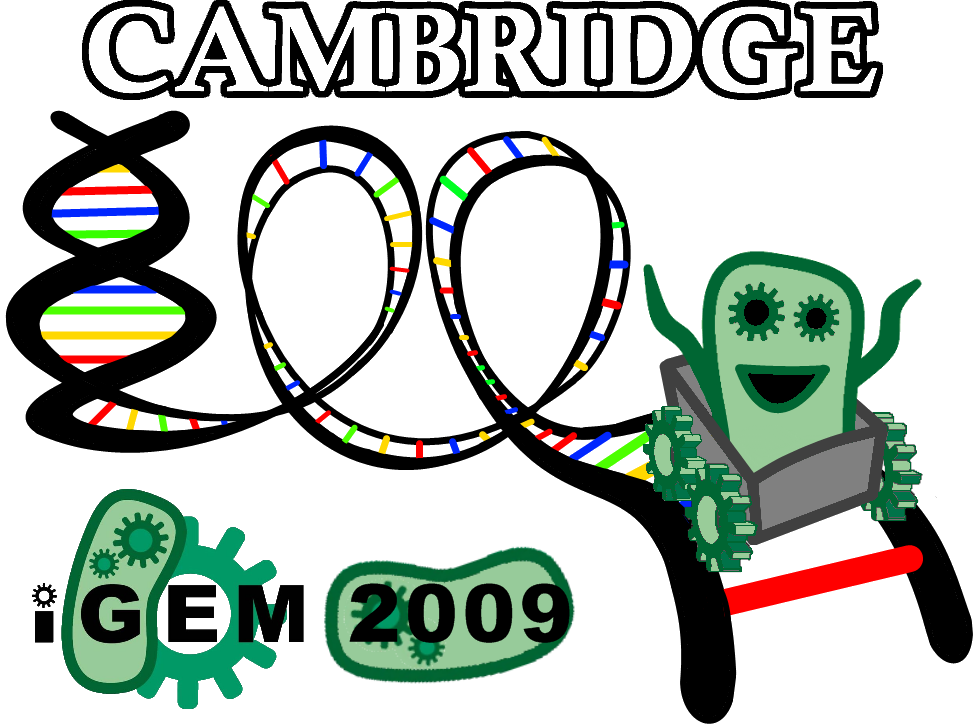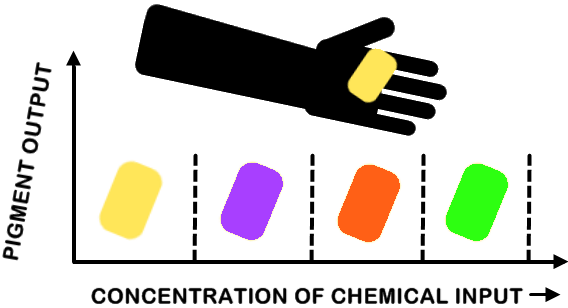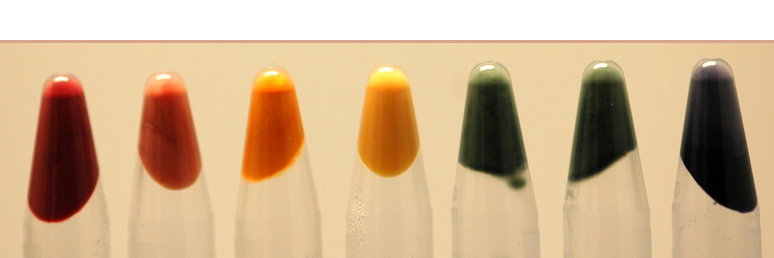|
|
| (91 intermediate revisions not shown) |
| Line 1: |
Line 1: |
| - | {|align="justify" | + | {{Template:Cambridge2}}<!--Do not remove the first and last lines in this page!--> |
| - | |.
| + | =E. Chromi= |
| - | |[[Image:cam09logo.png|289px|right|frame]]
| + | [[Image:Cambridge_Frontpage2.png|400px|right]] |
| - | |- | + | [[Image:RAINBOW.png|400px|right]] |
| - | | | + | '''The Cambridge [https://2009.igem.org/Main_Page 2009 iGEM] team has created two kits of parts that will facilitate the design and construction of biosensors in the the future. |
| - | Previous iGEM teams have focused on genetically engineering bacteria to respond to novel inputs – for example light, or biologically significant compounds. There is an unmistakable need, therefore, to also develop clear, user-friendly outputs, especially for use with biosensors. The most popular output is the expression of a fluorescent protein, detectable using fluorescence microscopy. However, how much easier would it be if we could simply ''see'' the output with our own eyes? The Cambridge 2009 iGEM team is engineering E. coli to produce a range of pigments in order to equip future projects with better, more reliable, discrete outputs under logic control. Further, our bacteria utilize a shutter mechanism that guarantees pigment production after just a brief exposure to the desired input.
| + | |
| - | |[[Image:Team.png|right|frame|Your team picture]]
| + | |
| - | |-
| + | |
| - | |
| + | |
| - | |align="center"|[[Team:Cambridge | Team Example]]
| + | |
| - | |}
| + | |
| | | | |
| - | <!--- The Mission, Experiments --->
| + | Previous iGEM teams have focused on genetically engineering bacterial biosensors by enabling bacteria to respond to novel inputs, especially biologically significant compounds. There is an unmistakable need to also develop devices that can '''1) manipulate input by changing the behaviour of the response of the input-sensitive promoter''', and that can '''2) report a response using clear, user-friendly outputs'''. The most popular output is the expression of a fluorescent protein, detectable using fluorescence microscopy. But, what if we could simply see the output with our own eyes? |
| | | | |
| - | {| style="color:#1b2c8a;background-color:#0c6;" cellpadding="3" cellspacing="1" border="1" bordercolor="#fff" width="62%" align="center"
| + | We successfully characterised a set of transcriptional systems for calibrated output - [https://2009.igem.org/Team:Cambridge/Project/Amplification Sensitivity Tuners]. We also successfully expressed a spectrum of pigments in ''E. coli,'' designing a set of [https://2009.igem.org/Team:Cambridge/Project/Pigments Colour Generators]. |
| - | !align="center"|[[Team:Cambridge|Home]]
| + | |
| - | !align="center"|[[Team:Cambridge/Team|The Team]]
| + | |
| - | !align="center"|[[Team:Cambridge/Project|The Project]]
| + | |
| - | !align="center"|[[Team:Cambridge/Parts|Parts Submitted to the Registry]]
| + | |
| - | !align="center"|[[Team:Cambridge/Modelling|Modelling]]
| + | |
| - | !align="center"|[[Team:Cambridge/Notebook|Notebook]]
| + | |
| - | !align="center"|[[Team:Cambridge/Protocols|Protocols]]
| + | |
| - | |}
| + | |
| - | (''Or you can choose different headings. But you must have a team page, a project page, and a notebook page.'')
| + | |
| | | | |
| - | {{Cambridge/Notitle}}
| |
| - | <div class=bodytable>
| |
| - | </div>
| |
| - | __NOTOC__
| |
| - | {{Cambridge09}}
| |
| - | <html>
| |
| - | <table width=100% style="background:#444; padding:15px;">
| |
| | | | |
| - | <tr>
| |
| - | <td style="height: 400; padding-left: 15px;">
| |
| - | <b class="b1f"></b><b class="b2f"></b><b class="b3f"></b><b class="b4f"></b>
| |
| - | <div class="contentf">
| |
| - | <div style="height: 400; background:#fff; line-height:170% padding: 3px 0px;">
| |
| - | <h1>Overview</h1>
| |
| - | <b>Previous iGEM teams have focused on genetically engineering bacteria to respond to novel inputs – for example light, or biologically significant compounds. There is an unmistakable need, therefore, to also develop clear, user-friendly outputs, especially for use with biosensors. The most popular output is the expression of a fluorescent protein, detectable using fluorescence microscopy. However, how much easier would it be if we could simply ''see'' the output with our own eyes? The Cambridge 2009 iGEM team is engineering E. coli to produce a range of pigments in order to equip future projects with better, more reliable, discrete outputs under logic control. Further, our bacteria utilize a shutter mechanism that guarantees pigment production after just a brief exposure to the desired input. </b>
| |
| - | </div></div>
| |
| - | <b class="b4f"></b><b class="b3f"></b><b class="b2f"></b><b class="b1f"></b>
| |
| - | </td>
| |
| - | </tr>
| |
| - | <tr>
| |
| - | <td colspan=3>
| |
| - | <b class="b1f"></b><b class="b2f"></b><b class="b3f"></b><b class="b4f"></b>
| |
| - | <div class="contentf">
| |
| - | <div style="height: 400; padding: 5px; background:#fff;">
| |
| - | <h1>The Project</h1>
| |
| - | Under construction <br /><b> Under construction </b> <a href="https://2009.igem.org/Team:Cambridge/Project"> Read on...</a>
| |
| - | </div>
| |
| - | </div>
| |
| - | <b class="b4f"></b><b class="b3f"></b><b class="b2f"></b><b class="b1f"></b>
| |
| - | </td>
| |
| - | </tr>
| |
| - | <tr>
| |
| - | <td colspan=3>
| |
| - | <b class="b1f"></b><b class="b2f"></b><b class="b3f"></b><b class="b4f"></b>
| |
| - | <div class="contentf">
| |
| - | <div style="height: 400; padding: 5px; background:#fff;">
| |
| - | <h1>The Team</h1>
| |
| - | Under construction. <br /><b> Under construction. </b> <a href="https://2009.igem.org/Team:Cambridge/Team"> Read on...</a>
| |
| - | </div>
| |
| - | </div>
| |
| - | <b class="b4f"></b><b class="b3f"></b><b class="b2f"></b><b class="b1f"></b>
| |
| - | </td>
| |
| - | </tr>
| |
| - | <tr>
| |
| - | <td colspan=3>
| |
| - | <b class="b1f"></b><b class="b2f"></b><b class="b3f"></b><b class="b4f"></b>
| |
| - | <div class="contentf">
| |
| - | <div style="height: 400; padding: 5px; background:#fff;">
| |
| - | <h1>Protocol</h1>
| |
| - | Under construction<br /> <b> Under construction. </b>
| |
| - | <a href="https://2009.igem.org/Team:Cambridge/Protocol"> Read on...</a>
| |
| | | | |
| - | </div>
| |
| - | </div>
| |
| - | <b class="b4f"></b><b class="b3f"></b><b class="b2f"></b><b class="b1f"></b>
| |
| - | </td>
| |
| - | </tr>
| |
| - | <tr>
| |
| - | <td colspan=3>
| |
| - | <b class="b1f"></b><b class="b2f"></b><b class="b3f"></b><b class="b4f"></b>
| |
| - | <div class="contentf">
| |
| - | <div style="height: 400; padding: 5px; background:#fff;">
| |
| - | <h1>Notebook</h1>
| |
| - | Under construction.</b> <a href="https://2009.igem.org/Team:Cambridge/Notebook">Read on...</a>
| |
| - | </div>
| |
| - | </div>
| |
| - | <b class="b4f"></b><b class="b3f"></b><b class="b2f"></b><b class="b1f"></b>
| |
| - | </td>
| |
| - | </tr>
| |
| - | <tr>
| |
| - | <td colspan=3>
| |
| - | <b class="b1f"></b><b class="b2f"></b><b class="b3f"></b><b class="b4f"></b>
| |
| - | <div class="contentf">
| |
| - | <div style="height: 400; padding: 5px; background:#fff; line-height:170%" align="center">
| |
| - | <table>
| |
| - | <tr>
| |
| - | <td width="200"><a href="http://www.bmglabtech.com/" class="noborder"><img src="http://www.labtop.at/pics/BMG_LABTECH_Logo_www2Ctrans.gif" alt="BMG-Labtech" width="140" height="38"></a></td>
| |
| | | | |
| - | <td width="200"><a href="http://www.sigmaaldrich.com/"><img src="http://upload.wikimedia.org/wikipedia/en/thumb/0/09/Sigma-Aldrich_logo.svg/116px-Sigma-Aldrich_logo.svg.png" alt="Sigma-Aldrich" width="116" height="39"></a></td>
| |
| | | | |
| - | <td width ="200"><a href="http://www.bio-rad.com/"><img src="http://www.bio-rad.com/evportal/framework/skins/evolution/images/biorad_logo.gif" alt="Bio-Rad Laboratories" width="100" height="27"></a></td>
| |
| - | </tr>
| |
| | | | |
| - | <tr>
| |
| - | <td><a href="http://www.invitrogen.com/site/us/en/home.html"><img src="http://www.gen.cam.ac.uk/Images/logos/iGEMsponsors/invirtogen.jpg" alt="invitrogen" width="160" height="25"></a></td>
| |
| - | <td><a href="http://www.medical-solutions.co.uk/"><img src="http://www.gen.cam.ac.uk/Images/logos/iGEMsponsors/geneservice.jpg" alt="geneservice" width="140" height="26"></a></td>
| |
| - | <td><a href="http://www.bioscience.co.uk/"><img src="http://www.gen.cam.ac.uk/Images/logos/iGEMsponsors/cambridgebioscience.jpg" alt="cambridge bioscience" width="157" height="42"></a></td>
| |
| - | </tr>
| |
| - | <tr>
| |
| - | <td><a href="http://www.zymoresearch.com/"><img src="http://www.gen.cam.ac.uk/Images/logos/iGEMsponsors/zymoresearch.jpg" alt="zymo research" width="135" height="45"></a></td>
| |
| - | <td><a href="http://www.vwr.com/index.htm"><img src="http://www.gen.cam.ac.uk/Images/logos/iGEMsponsors/vwr.jpg" alt="VWR" width="140" height="47"></a></td>
| |
| - | <td><a href="http://www.microzone.co.uk/"><img src="http://www.gen.cam.ac.uk/Images/logos/iGEMsponsors/microzone.gif" alt="Microzone" width="131" height="44"></a></td>
| |
| - | </tr>
| |
| - | <tr>
| |
| - | <td><a href="http://www.finnzymes.com/"><img src="http://www.gen.cam.ac.uk/Images/logos/iGEMsponsors/finnzymes.jpg" alt="Finnzymes" width="131" height="43"></a></td>
| |
| - | <td><a href="http://www.fisher.co.uk/"><img src="http://www.gen.cam.ac.uk/Images/logos/iGEMsponsors/fisherscientific.jpg" alt="Fisher Scientific" width="132" height="33" /></a></td>
| |
| - | <td><a href="http://www.dna20.com/"><img src="http://openwetware.org/images/8/88/Dna20_logo.jpg" alt="DNA 2.0" width="132" height="66" /></a></td>
| |
| - | </tr>
| |
| - | </table>
| |
| - | </div>
| |
| - | </div>
| |
| - | <b class="b4f"></b><b class="b3f"></b><b class="b2f"></b><b class="b1f"></b>
| |
| - | </td>
| |
| | | | |
| - | </tr>
| + | |
| - | </table> | + | |
| | + | |
| | + | |
| | + | |
| | + | |
| | + | |
| | + | |
| | + | |
| | + | |
| | + | |
| | + | |
| | + | |
| | + | |
| | + | |
| | + | |
| | + | |
| | + | |
| | + | |
| | + | |
| | + | |
| | + | |
| | + | <html> |
| | + | <style type="text/css"> |
| | + | .imagelink_1 a { |
| | + | width:240px; |
| | + | height:160px; |
| | + | display:block; |
| | + | position:absolute; |
| | + | left:30px; |
| | + | top:460px; |
| | + | text-decoration:none; |
| | + | background-image: url("https://static.igem.org/mediawiki/2009/5/50/Frontpage1.png") |
| | + | } |
| | + | .imagelink_2 a { |
| | + | width:240px; |
| | + | height:160px; |
| | + | display:block; |
| | + | position:absolute; |
| | + | left:270px; |
| | + | top:460px; |
| | + | text-decoration:none; |
| | + | background-image: url("https://static.igem.org/mediawiki/2009/b/bd/Frontpage2b.png") |
| | + | } |
| | + | .imagelink_3 a { |
| | + | width:240px; |
| | + | height:160px; |
| | + | display:block; |
| | + | position:absolute; |
| | + | left:510px; |
| | + | top:460px; |
| | + | text-decoration:none; |
| | + | background-image: url("https://static.igem.org/mediawiki/2009/3/3d/Frontpage3.png") |
| | + | } |
| | + | .imagelink_4 a { |
| | + | width:240px; |
| | + | height:160px; |
| | + | display:block; |
| | + | position:absolute; |
| | + | left:30px; |
| | + | top:620px; |
| | + | text-decoration:none; |
| | + | background-image: url("https://static.igem.org/mediawiki/2009/f/f7/Frontpage4.png") |
| | + | } |
| | + | .imagelink_5 a { |
| | + | width:240px; |
| | + | height:160px; |
| | + | display:block; |
| | + | position:absolute; |
| | + | left:270px; |
| | + | top:620px; |
| | + | text-decoration:none; |
| | + | background-image: url("https://static.igem.org/mediawiki/2009/5/53/Frontpage5.png") |
| | + | } |
| | + | .imagelink_6 a { |
| | + | width:240px; |
| | + | height:160px; |
| | + | display:block; |
| | + | position:absolute; |
| | + | left:510px; |
| | + | top:620px; |
| | + | text-decoration:none; |
| | + | background-image: url("https://static.igem.org/mediawiki/2009/f/f6/Frontpage6.png") |
| | + | } |
| | + | </style> |
| | </html> | | </html> |
| | + | |
| | + | <div class="imagelink_1">[https://2009.igem.org/Team:Cambridge/Project]</div><div class="imagelink_2">[https://2009.igem.org/Team:Cambridge/Project/Amplification]</div><div class="imagelink_3">[https://2009.igem.org/Team:Cambridge/Project/Pigments]</div><div class="imagelink_4">[https://2009.igem.org/Team:Cambridge/ImageGallery/TEAM]</div><div class="imagelink_5">[https://2009.igem.org/Team:Cambridge/Team]</div><div class="imagelink_6">[https://2009.igem.org/Team:Cambridge/ImageGallery]</div> |
| | + | |
| | + | ==== The E. Chromi Team, in Cambridge's 800th year ==== |
| | + | [[Image:Cambridgeteamphoto.png | 360px]][[Image:IGEMTSHIRTtrans2.png | 360px]] |
| | + | <!--Do not remove the first and last lines in this page!-->{{Template:CambridgeBottom}} |
E. Chromi
The Cambridge 2009 iGEM team has created two kits of parts that will facilitate the design and construction of biosensors in the the future.
Previous iGEM teams have focused on genetically engineering bacterial biosensors by enabling bacteria to respond to novel inputs, especially biologically significant compounds. There is an unmistakable need to also develop devices that can 1) manipulate input by changing the behaviour of the response of the input-sensitive promoter, and that can 2) report a response using clear, user-friendly outputs. The most popular output is the expression of a fluorescent protein, detectable using fluorescence microscopy. But, what if we could simply see the output with our own eyes?
We successfully characterised a set of transcriptional systems for calibrated output - Sensitivity Tuners. We also successfully expressed a spectrum of pigments in E. coli, designing a set of Colour Generators.
The E. Chromi Team, in Cambridge's 800th year


 "
"



